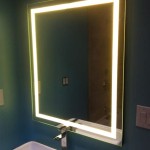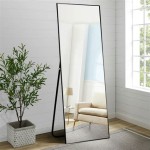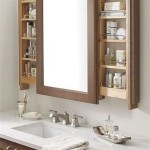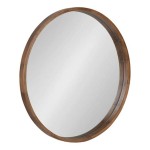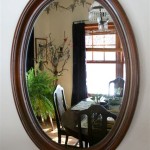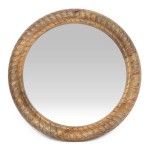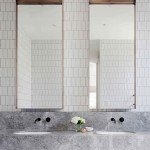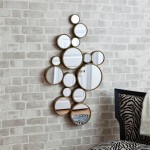Hanging a Large Mirror Without Nails
Hanging a large mirror can be a daunting task, especially if avoiding wall damage is a priority. Fortunately, several effective methods allow for secure mirror mounting without the need for nails. These methods vary in their weight capacity and suitability for different wall types, offering flexibility depending on individual needs and circumstances.
Key Considerations Before Starting
Before selecting a hanging method, certain factors should be considered to ensure safety and stability:
- Mirror Weight: Heavier mirrors require more robust hanging solutions. Always verify the weight capacity of the chosen method.
- Wall Type: Different wall types (e.g., drywall, plaster, concrete) have varying load-bearing capacities and compatibility with different adhesives.
- Mirror Size and Shape: Larger and irregularly shaped mirrors may require additional support points.
- Location and Environment: Consider factors like humidity and temperature fluctuations, as these can affect adhesive strength.
Method 1: Adhesive Strips
Adhesive strips designed specifically for hanging mirrors offer a convenient and damage-free solution. These strips utilize a strong adhesive that bonds to both the mirror and the wall. They come in various sizes and weight capacities, allowing for selection based on the mirror's dimensions and weight.
Key Points for Using Adhesive Strips
- Surface Preparation: Clean both the wall and the back of the mirror with isopropyl alcohol to ensure optimal adhesion.
- Weight Limits: Carefully follow the manufacturer's instructions regarding weight limits and the number of strips required.
- Application: Apply the strips to the back of the mirror according to the product instructions, then firmly press the mirror against the wall for the specified duration.
- Curing Time: Allow the adhesive to cure fully before releasing the mirror completely, as per the manufacturer's guidelines.
Method 2: Mirror Mounting Tape
Similar to adhesive strips, mirror mounting tape provides a strong bond for hanging mirrors without nails. This double-sided tape is specifically formulated for mirrors and offers a continuous adhesive surface, which can be beneficial for larger or heavier mirrors.
Key Points for Using Mirror Mounting Tape
- Surface Preparation: Clean both surfaces thoroughly with isopropyl alcohol.
- Tape Application: Apply the tape to the back of the mirror in vertical strips, ensuring even coverage.
- Wall Contact: Carefully position the mirror on the wall and press firmly for the recommended time to ensure a secure bond.
- Support During Curing: For heavier mirrors, consider supporting the mirror with temporary props while the adhesive cures.
Method 3: Heavy-Duty Hooks with Adhesive Backing
For heavier mirrors, heavy-duty hooks designed for picture hanging can be adapted for use with mirrors. These hooks typically feature a strong adhesive backing and a weight-bearing hook or hanger.
Key Points for Using Heavy-Duty Hooks
- Weight Capacity: Select hooks with a weight capacity significantly exceeding the mirror's weight.
- Surface Preparation: Clean both the wall and the hook's adhesive backing thoroughly.
- Secure Attachment: Firmly press the hook onto the wall for the recommended duration, ensuring a strong bond.
- Wire or D-Rings: Attach D-rings or wire to the back of the mirror for hanging on the hooks.
- Even Distribution: Use multiple hooks spaced evenly to distribute the weight of the mirror effectively.
Method 4: Leaning the Mirror
While not a traditional hanging method, leaning a large mirror against the wall can create a stylish and impactful display. This method is best suited for larger, heavier mirrors that might be challenging to hang using adhesives.
Key Points for Leaning a Mirror
- Stability: Ensure the mirror is leaning at a safe angle to prevent tipping.
- Wall Anchors (Optional): For added security, consider using small, clear wall anchors to secure the top edge of the mirror to the wall.
- Floor Protection: Place felt pads or other protective material under the bottom edge of the mirror to prevent scratching the floor.
Method 5: French Cleats
French cleats offer a robust and versatile hanging solution for heavier items, including large mirrors. A French cleat consists of two interlocking pieces of wood, one attached to the wall and the other to the back of the mirror.
Key Points for Using French Cleats
- Cleat Size: Choose cleats appropriate for the size and weight of the mirror.
- Wall Attachment: Securely attach the wall portion of the cleat to the wall using appropriate fasteners.
- Mirror Attachment: Attach the mating cleat to the back of the mirror, ensuring proper alignment.
- Interlocking: Carefully hang the mirror by interlocking the two cleat pieces.
Selecting the right hanging method depends on the specific characteristics of the mirror and the wall. By carefully considering these factors and following the appropriate instructions, it is possible to securely hang a large mirror without causing damage to the wall.

How To Hang A Heavy Mirror In 5 Simple Steps

How To Hang A Mirror On Wall Without Nails Guide For All Diyers

Hang A Mirror Without Nails Diyer S Guide To Great Results

How To Hang A Mirror On Wall Without Nails

3 Simple Ways To Hang A Mirror On Wall Without Nails Wikihow

How To Hang A Heavy Mirror At Home

How To Hang A Hanging Mirror Without Accompanying Hardware

3 Simple Ways To Hang A Mirror On Wall Without Nails Wikihow

3 Simple Ways To Hang A Mirror On Wall Without Nails Wikihow

3 Simple Ways To Hang A Mirror On Wall Without Nails Wikihow

